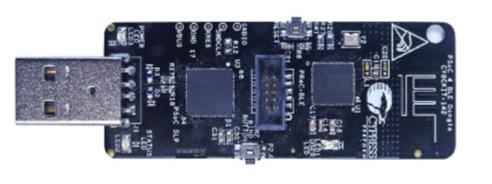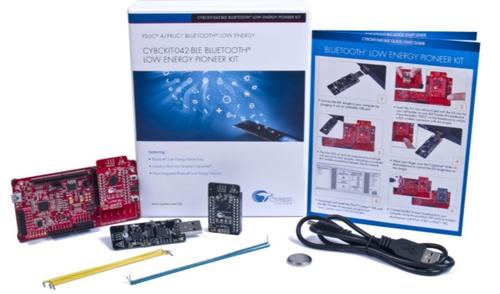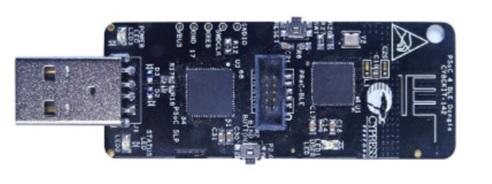March 17, 2015

Editor's Note: Don Wilcher is an electrical engineer with 26 years of experience in industrial robotics, automotive systems, and consumer appliances. A passionate teacher of electronics technology, Don is a regular lecturer for Design News' Continuing Education Center (CEC) of interactive online tutorials.
With the Internet of Things (IoT) being one of today's most important tech trends, development and prototyping work with low-power wireless sensor-based systems in electronics and home appliances, as well as automotive and industrial control products, will only grow in our increasingly connected world.
Cypress Semiconductor created the BLE (Bluetooth Low Energy) Pioneer Kit to enable system designers to start that work. When the kit became available, I decided to start exploring this technology myself. Upon opening the plastic storage case, I was intrigued with its nicely packaged contents. Inside the BLE Pioneer Kit were the following components:
(1) BLE Pioneer baseboard
(1) CySmart USB dongle
(1) PSoC 4 BLE module
(1) PRoC (Programmable Radio on Chip) BLE module
(1) USB cable
(1) 3.0V coin-sized lithium battery
(1) Package of pre-formed jumper wires
(1) Quick start guide

You can think of the BLE Pioneer Baseboard as the motherboard for the kit. Its main processor is a PSoC 4 BLE ARM Cortex M0-based reconfigurable microcontroller. The operating frequency for the BLE-based microcontroller is 48 MHz. It includes 128 kb of Flash memory along with 16 kb of SRAM (static RAM) for additional programming space.
The onboard radio is a 2.4 GHz transceiver with an integrated 50 ohm antenna driver. Although the BLE Pioneer baseboard is slightly larger than an Arduino Mega 2560, I was quite amazed with the accessibility to the PSoC 4's GPIO (General Purpose Input Output) pins. The baseboard has several female headers, like an Arduino, which eases the addition of your own I/O circuits. There's even a CapSense slider control that can be used to build baseboard touch-sense BLE applications, as well.
Also impressive is that all of this processing power and accessible I/O are driven by one 3V coin-sized lithium battery. The quick start guide that comes packaged with the kit recommends removing the battery when not in use to extend its operating life.

The kit has PRoC BLE and PSoC 4 reconfigurable microcontrollers, an onboard antenna, a user button, and a blue LED. The latter can be controlled with baseboard as well as provide a visual indicator of when the PSoC 4 BLE module and CySmart USB dongle are connected (paired) together. To demonstrate the ease of connecting the two devices, Cypress has provided a ready example for testing. When the baseboard and USB dongle are wirelessly connected, you are able to adjust the blue LED's intensity by sliding your finger on the CapSense slider control.
The PRoC (blue) and PSoC 4 (red) BLE modules are reconfigurable transceivers for the baseboard. Both reconfigurable microcontrollers have the same electrical and operating specifications as the baseboard with exception of the radios. The PRoC BLE module has a smart radio instead of an ordinary BLE radio. Both the PRoC and PSoC 4 BLE modules are easily programmed using the PSoC Creator 3.1 software as well as the CySmart tool.
MORE FROM DESIGN NEWS: Battle Scenes from the IoT Standards War
The CySmart USB dongle is the wireless interface to the CySmart application software. CySmart allows a detailed analysis into the example PSoC 4 BLE applications provided by Cypress' PSoC Creator 3.1 software. Specific functions and features associated with the Bluetooth BLE 4.1 Specification, such as GATT (Generic Attribute Profile) and GAP (Generic Access Profile), can be examined using the CySmart software.
The target PSoC 4 BLE application RF data can be monitored and managed using the CySmart software with the wireless USB dongle. A mobile app can be used to monitor and control the target PSoC 4 BLE application by smartphone installation. The desktop version provides the same data management capabilities as the mobile app, as well.
On the Cypress website, there are wealth of resources, such as application notes, tools, and software, to get you developing your IoT applications easily. Some of the applications that I will be exploring with the BLE Pioneer Kit are IoT sensing devices, remote-controlled appliances, STEM and CTE (Career Technical Education) training tools, and industrial controls.
Getting Hands-On with Cypress' PSoC
Register today!
Finally, I'll be conducting a deep dive into the PRoC and PSoC BLE modules in my weeklong Design News online course titled "Getting Hands-On with Cypress' PSoC." The series of classes -- part of the publication's Continuing Education Center (CEC), sponsored by Digi-Key, and where attendees can earn IEEE Professional Development Hours -- will be held March 30 to April 3.
Don Wilcher is a passionate teacher of electronics technology and an electrical engineer with 26 years of industrial experience. He's worked on industrial robotics systems, automotive electronic modules /systems, and embedded wireless controls for small consumer appliances. He's also a book author, writing DIY project books on electronics and robotics technologies. His latest book, Make: Basic Arduino Projects, published by Maker Media, is on the Alabama State Department's approved Career and Technical Education (CTE) reading list. He's currently developing 21st century educational training products and curriculum focusing on Internet of Things (IoT) and Industrial Physical Computing for makers, engineers, technicians, and educators. Besides being an Electrical Engineer, he's a Certified Electronics Technician with ETA International and Alabama State Certified Electronics Instructor.
About the Author(s)
You May Also Like





